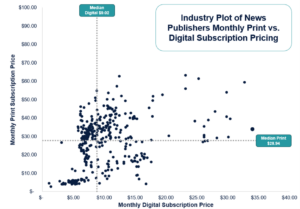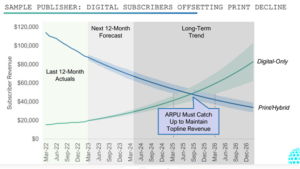Increasing Digital ARPU, a necessity for News Publishers
Subscription revenue is the primary revenue stream for most news publishers and maintaining subscription revenue and operating margins through the transition from print to digital products is a key objective for achieving a sustainable digital publishing business model.
Average print subscription rates increased substantially over the past ten years as publishers replaced advertising revenue lost to digital platforms. Growth in print subscription revenue was realized using strategic pricing processes that minimize churn from price increases. Our experience with clients shows this pricing technique reduces price-related churn by 50% and increases net revenue yield by over 40%. We have written about the importance of strategic print subscription processes many times in this blog.
A similar increase in average price is needed for digital products for news publishers to achieve digital sustainability. Many progressive publishers have embarked on a strategic pricing path for digital subscriptions to increase their digital ARPU.
What have we learned about digital ARPU so far?
- Strategic subscription pricing processes have been applied to digital-only subscriptions with similar success, which demonstrates audiences’ willingness to pay for access to publisher’s content on alternative platforms.
- Regional and local news organizations need to achieve higher average revenue per subscriber to achieve sustainable revenue levels given the smaller addressable markets for their products. News publishers should not compare themselves to Netflix, Spotify, and other international brands regarding pricing strategy. We like to quote one of our long-term customers who said, “you can’t out-volume rate.”
The following chart illustrates the median print and digital subscription prices for over 400 news publishers in North America. This data comes from our work with publishers on their strategic pricing processes, and they represent the actual prices paid by customers net of promotional offers or discounts and not the list prices of these products.
The median print subscription price in this data is US$28.54 per month. The median digital subscription price is US$9.02 per month, less than 1/3rd the print price. Despite the lower operating costs for digital products, profit margins are often not equal to the margin on print products due to the lower revenue per customer.
Digital subscription prices will be lower than print for several reasons, including the lower average tenure of a digital subscription compared to print subscriptions. Average rates tend to increase over time, so newer customers will pay less on average.

Subscription Milestones in Digital Transition
We forecast three crossover points between print and digital subscriptions. The volume crossover point, where digital subscriptions are 50% of total subscriptions, will likely occur for the industry in 2024. Digital subscriptions are about 40% of total subscriptions in our benchmarking data.
The revenue crossover point is farther in the future due to the much higher print rates. Digital-only subscription revenue is about 20% of total subscription revenue today, and we predict it will not equal print revenue for several years.
The operating margin crossover point is harder to predict since there are significant differences in operating costs across publishers, and extrapolating costs for delivery and production is challenging, but we expect the digital operating margin will overtake the print operating margin after the volume crossover and before the revenue crossover.
The chart below illustrates the crossover point for revenue predicted for publishers in our benchmarking data set. Accelerating the growth in digital ARPU shortens the time to that crossover point.

How to increase digital ARPU?
Publishers must increase digital ARPU while sustaining sufficient subscription volumes to reach their sustainable revenue objectives. We have found that strategic pricing is effective at raising average rates and minimizing churn when implemented as subscribers reach their renewal date or the end of their promotional offer period.
Acquisition offer optimization is effective at maximizing expected lifetime value. Personalized pricing at acquisition can be problematic given the limited information on the reader, although it can be effective in some cases.
What are the challenges in increasing ARPU?
Strategic pricing seeks to match prices with the value provided to the reader, which varies across your audience segments. Modeling customer value perception and price elasticity must be done in compliance with data privacy regulations. Generally, this requires anonymization and aggregation of customer data. We have worked with publishers to optimize pricing under these limitations.
Another point to consider is that pricing processes involve much more than price elasticity modeling. An organization needs to coordinate customer communication across the touchpoints along a customer’s lifecycle and journey. They also need to work within the technical capabilities of their billing systems and other applications.
How do you know as a publisher that your ARPU is at the right level?
Metrics for the subscription sales funnel, conversion, and post-conversion engagement can indicate how your organization is performing. Successful subscription businesses require doing many things well, and knowledge of where opportunities exist for operational improvement is a big advantage to an organization.
Metrics specific to pricing strategy performance include conversion rates, retention rates, incremental stop rates, price reverts (retention offers), and the ratio of net increase to gross increase. We recommend ongoing A/B testing for price changes, both at acquisition, end-of-promotion price changes, and annual renewals.

